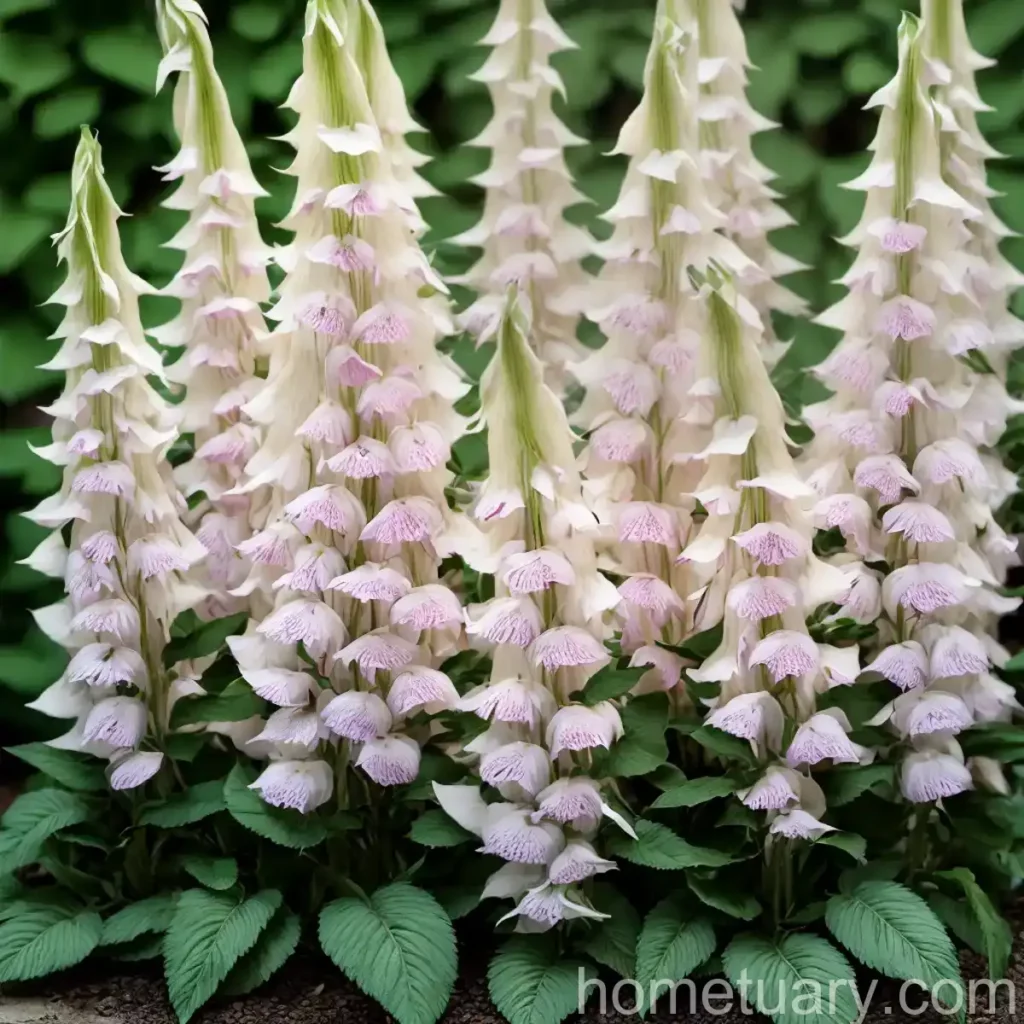Foxglove (Digitalis ‘Takforoiv’ FOXLIGHT ROSE IVORY): A Stunning Plant for Your Garden
Introduction
Gardening is an immensely rewarding hobby, and the joy of seeing vibrant, healthy plants thriving in your garden is unmatched. One such stunning addition to any garden is the foxglove (Digitalis ‘Takforoiv’ FOXLIGHT ROSE IVORY). With its elegant, tubular blooms and variety of uses, foxglove is a must-have for both novice and experienced gardeners. In this article, we will delve into the world of foxglove, exploring its culture, uses, care instructions, and much more.
What is Foxglove (Digitalis ‘Takforoiv’ FOXLIGHT ROSE IVORY)?
The Digitalis ‘Takforoiv’ FOXLIGHT ROSE IVORY, commonly known as foxglove, is a hybrid variety of the Digitalis purpurea plant. It is renowned for its striking, trumpet-shaped flowers that come in an array of colors, including rose and ivory. This perennial plant is a favorite among gardeners for its ornamental qualities and versatility in various garden settings.
Key Takeaways
Below are essential key takeaways regarding foxglove (Digitalis ‘Takforoiv’ FOXLIGHT ROSE IVORY):
- Foxglove ‘Takforoiv’ hybrid is a stunning variety known for its rose and ivory tubular flowers.
- It is a Digitalis purpurea hybrid that adds a touch of elegance to any garden.
- Foxglove is known for its ornamental value and a variety of uses, making it a versatile addition to any landscape.
Now that we have an overview of foxglove, let’s explore the culture, uses, and care tips for this exquisite plant.
Culture
Water
Foxglove plants thrive in well-drained soil and prefer evenly moist conditions. While they require regular watering, it’s important to avoid waterlogging the soil. Consistent moisture is key to promoting healthy growth and vibrant blooms.
Sunlight
When it comes to sunlight, foxglove plants prefer partial to full shade. While they can tolerate some sun, especially in cooler climates, they generally thrive in locations with dappled sunlight. Planting them in areas with protection from the harsh afternoon sun is ideal.
Fertilizer
In terms of fertilizer, a balanced, all-purpose fertilizer applied in early spring can help provide the nutrients foxglove plants need for robust growth and blooming. It’s essential to follow the recommended application rates for the specific fertilizer you choose and avoid over-fertilizing, which can lead to excessive foliage growth at the expense of flowers.
Soil
Foxglove plants prefer acidic to slightly alkaline soil with good drainage. Amending the soil with organic matter, such as compost, can help improve its texture and fertility, creating an optimal growing environment for foxglove.
Uses
Ornamental Value
One of the primary uses of foxglove (Digitalis ‘Takforoiv’ FOXLIGHT ROSE IVORY) is its ornamental value. Its graceful, bell-shaped flowers add beauty and charm to gardens, making it a popular choice for borders, woodland settings, and cottage gardens.
Medicinal Purposes
While it’s essential to exercise caution due to the plant’s toxic nature, foxglove has historical medicinal uses. The plant contains compounds that have been used in the development of medications to treat heart conditions. However, it’s crucial to note that the therapeutic use of foxglove requires expertise and supervision from healthcare professionals.
Care Instructions
Now, let’s explore some essential care instructions to ensure your foxglove plants thrive and flourish in your garden.
Pruning
Pruning is an essential aspect of foxglove care. Deadheading spent blooms can encourage the plant to produce more flowers and extend the blooming period. Additionally, removing any yellowing or damaged foliage can help maintain the plant’s overall health and appearance.
Propagation
Foxglove plants can be propagated through seeds or division. Sowing seeds in early summer can lead to new plants the following year. Additionally, dividing mature plants can help rejuvenate them and provide new specimens for different areas of the garden.
Container Popularity
Foxglove plants are also well-suited for container gardening, adding vertical interest to patio spaces and balconies. When growing foxglove in containers, ensure that the pots have adequate drainage holes to prevent waterlogging, and use a high-quality potting mix to provide the necessary nutrients for healthy growth.
Popularity
Foxglove in Landscapes
Foxglove (Digitalis ‘Takforoiv’ FOXLIGHT ROSE IVORY) is a popular choice in landscape design, adding a vertical element and a pop of color to various garden settings. Its ability to thrive in partial shade makes it a versatile option for creating visually captivating landscapes.
Container Gardening
As mentioned earlier, foxglove’s popularity extends to container gardening, where it can be showcased on patios, decks, and other outdoor spaces. Its graceful, towering blooms make it a focal point in container arrangements.
Common Diseases
Like many plants, foxglove is susceptible to certain diseases. Being aware of common diseases and their symptoms can help in timely intervention and effective management.
Disease Diagnosis
Some common diseases that may affect foxglove plants include:
- Powdery Mildew: This fungal disease presents as a powdery white coating on the leaves, typically in warm, humid conditions.
- Leaf Spot: Leaf spot diseases can cause dark spots or lesions on the foliage, leading to aesthetic and potential health issues for the plant.
- Crown Rot: Excessive moisture and poor drainage can contribute to crown rot, which can cause wilting and decay of the crown and roots.
Common Pests
In addition to diseases, foxglove plants may also face challenges from various pests, including:
- Aphids: These small insects can cluster on the undersides of leaves, sucking out plant juices and potentially causing distorted growth.
- Slugs and Snails: These creatures can feed on the foliage of foxglove, leading to ragged edges and holes in the leaves.
Botanist’s Tips
To ensure the success of your foxglove plants, here are some valuable tips from botanists and experienced gardeners:
- Good Drainage: Providing well-drained soil is crucial to prevent waterlogging and related issues.
- Consistent Moisture: While foxglove plants prefer moist conditions, they should not be overwatered. Finding the right balance is key to their overall health.
- Observation: Regularly monitoring your foxglove plants for any signs of disease or pest infestations can help address issues promptly, preventing them from escalating.
Fun Facts
To further appreciate the beauty and relevance of foxglove in the botanical world, here are some intriguing fun facts:
- The name “foxglove” is said to have originated from the term “folk’s glove,” alluding to the idea of fairies wearing the flowers as gloves.
- Foxglove flowers are known to attract pollinators such as bees and hummingbirds, contributing to the biodiversity of gardens and landscapes.
Links to External Resources
For additional information on foxglove (Digitalis ‘Takforoiv’ FOXLIGHT ROSE IVORY) and related topics, refer to the following resources:
- Royal Horticultural Society – Foxglove Plant Guide
- University of Florida Gardening Solutions – Digitalis purpurea
- Better Homes & Gardens – Growing Foxglove Flowers
In conclusion, foxglove (Digitalis ‘Takforoiv’ FOXLIGHT ROSE IVORY) is a captivating plant that offers both aesthetic beauty and intriguing historical uses. With the right care and attention, this versatile plant can thrive in various garden settings, enriching landscapes with its elegant blooms and enchanting presence.
Whether you are drawn to its ornamental value, historical significance, or potential medicinal uses, incorporating foxglove into your garden can undoubtedly elevate its appeal and charm. By understanding its cultural requirements, uses, care instructions, and potential challenges, you can embark on a journey of cultivating and appreciating the grace and allure of foxglove in your own garden.
Remember to explore the provided external resources for further insights and guidance on nurturing foxglove plants, and enjoy the process of fostering these remarkable botanical treasures in your outdoor spaces.















